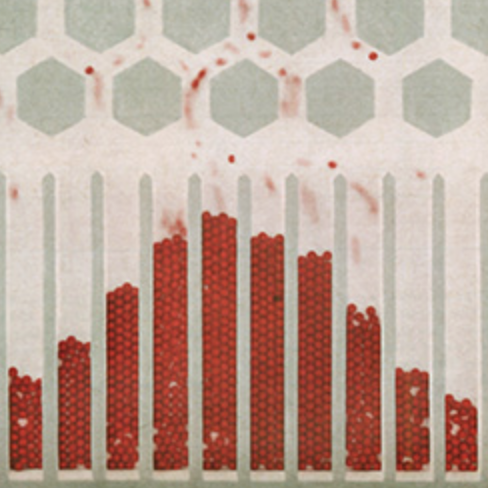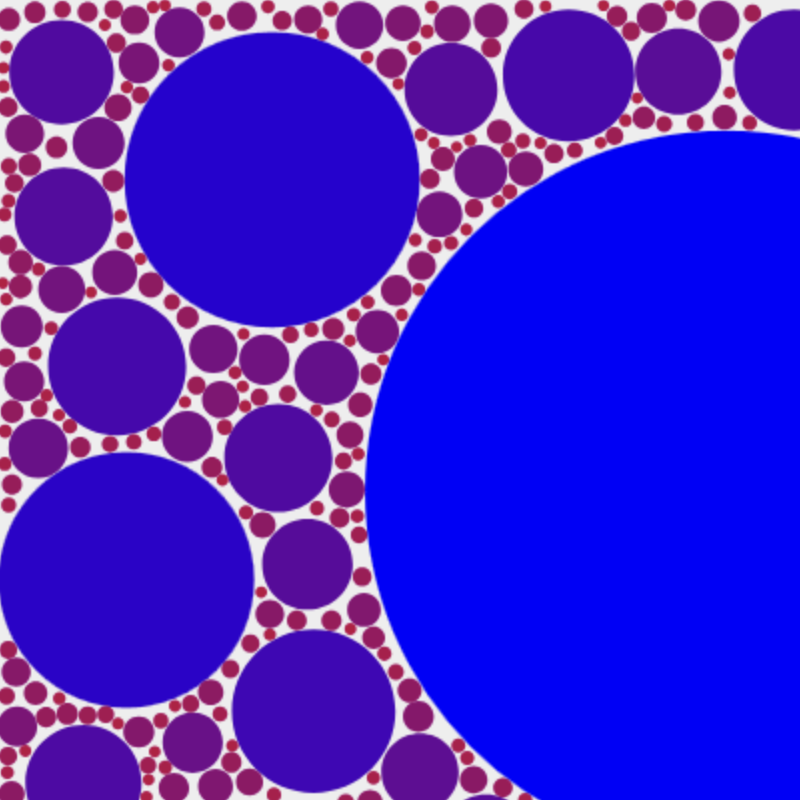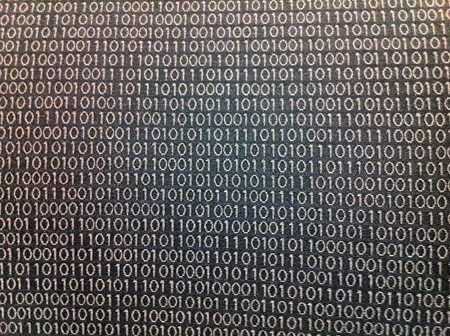Stop Lights
by Brian Hayes
Published 1 September 2012
For something like 80 years, a traffic light was an ordinary incandescent light bulb mounted behind a colored glass lens. Then, in 1999, LED signal lights began appearing at street corners; the light bulb was replaced by an array of small light-emitting diodes shining through a diffusing lens. LEDs are more efficient than incandescent bulbs, and they last longer. Moreover, having many LEDs instead of one tungsten filament offers the safety advantage of a gradual failure mode. As I wrote in my Field Guide to the Industrial Landscape: “If one small emitter burns out, the rest continue to shine.”
That sentence was written when LED traffic lights were still very new, and I had never actually seen one with a failed emitter. Now that the LED signals have several years of service behind them, I’ve begun to notice a lot of defects, and they don’t look like what I expected. Instead of random, isolated blemishes on the face of the signal, I’m seeing large scars and ragged craters. Oddly shaped blocks of emitters are all failing at once.
This is a pattern that turns up with notable frequency:

This one has three blocks of dead pixels:

And here almost half the emitters have gone dark:

All three of the examples above are green signal lights, which seem to fail much more often than red and yellow ones. But here’s an example of a red light with more than 20 blacked-out pixels and several more dim ones:

Finally, in another green light, a quite different and more orderly pattern of defects appears:

For me these images provoke a couple of questions. First, why do we so often see signal faces with a dozen or more LED failures, while single-pixel outages seem to be very rare? Second, what accounts for the distinctive shapes of the dark regions?
No doubt some diligent googling or wikipedia-wrangling would turn up some answers, but sometimes it’s just more fun to speculate in ignorance. In any case, I have a hypothesis about the first question. The idea comes from childhood experience with Christmas-tree lights. LEDs are generally low-voltage devices, but the available power supply in the traffic light is 120 volts. The cheapest and easiest way to deal with this mismatch is to wire groups of LEDs in series, thereby dividing the voltage. A consequence is that if any one LED in a group fails to an open-circuit state, the entire chain goes dark.
As for the geometric question, I haven’t got a clue. If I were laying out the circuit board, I would surely wind up with some collection of reasonably tidy, compact, symmetrical clusters. The patterns on exhibit here are not tidy, compact or symmetrical. The last of the images above might be explicable: Wiring together every other element in a row would be a good way of reducing the visual impact of a failure. But all the other patterns are incomprehensible.
Of course my whole Christmas-lights hypothesis may be totally screwy. I welcome alternative hypotheses, and even Google-Wiki-derived answers.
As a final bit of fun, here’s a video of an LED traffic signal shot at 1,000 frames per second, and slowed down by a further factor of 2, showing the 120-hertz flicker from the AC power supply, including the fade at the end of the green cycle.
Responses from readers:
Please note: The bit-player website is no longer equipped to accept and publish comments from readers, but the author is still eager to hear from you. Send comments, criticism, compliments, or corrections to brian@bit-player.org.
Publication history
First publication: 1 September 2012
Converted to Eleventy framework: 22 April 2025




I have no good ideas about the patterns, but I will speculate-in-ignorance about why the green lights seem to fail more often than the red ones. Could it be that LEDs of a slightly higher quality are intentionally used for red, for safety reasons? I’m guessing it’s marginally less critical if a green light fails, versus a red light failing (if the green light is malfunctioning, at-least people will still stop). Though I may be reading more intent into things than actually exists.
Oddly, I don’t see the video link while viewing this blog entry directly (at http://bit-player.org/2012/stop-lights), but it comes through fine in Google Reader. I’m using Chrome in both cases. Though in the latter case, it looks like it was supposed to be embedded, but didn’t quite make it (I only see the “Popout” link, which opens a blank window, and another for “Original video source (greenlight_slowmo.ogv)”, linking to “./assets/greenlight_slowmo.ogv”.) I was able to view it, but I thought you might like to know about the weirdness.
Regarding the failure rates of green vs red LEDs, it has to do with the materials. Red LEDs are generally made with a compound semiconductor called Aluminum Gallium Arsenide (AlGaAs). AlGaAs is a pretty well-understood material system, and has some nifty properties (e.g. AlAs and GaAs are nearly lattice-matched to one another) which make it a fairly robust platform for high power devices.
Unfortunately for us, AlGaAs LEDs simply cannot emit green light — in order to get green and blue LEDs we need to use materials in the Gallium Nitride (GaN) family, which are less well-behaved. GaN crystals are very difficult to grow, requiring much higher temperatures to achieve reasonable material quality. Modern manufacturing techniques can make decent GaN LEDs, but there are a lot more defects in the crystals. Over time the crystal defects grow, until eventually the device fails. Defect growth accelerates with temperature, so I’d expect to see more LEDs failing during the summer than the winter (although maybe not! Unlike the old bulbs, LED lights don’t get hot enough to melt the snow that piles up on them, so some municipalities have had to add heaters to the street light assemblies to keep the street lights visible in the winter. If the heater was set too high it could certainly contribute to LED failure). I could babble on about semiconductors for way too long (maybe I already have!), so let’s move on…
As to the patterns of failing bulbs, I think your explanation is probably correct, but I’m not positive. I’d bet that the different failure patterns are just due to different designs sold by different street light manufacturers. For instance, the first picture looks like there’s a ground ring around the circumference of the LED board, and the positive terminal of the LED string is at the center, giving you a ray-shaped LED string. Some of the others look like they just have clumps of LEDs on the same driver, and that final one has the characteristic “dead string” christmas light look.
Thanks to WW for the lucid explanation of high-band-gap semiconductors.
About the video problem reported by Paul DeLong: This is my first-ever venture into the stinking morass known as the HTML5 <video> tag. I knew I would regret it. I’ve tweaked the code a little more, but I don’t have great faith that my changes will solve everybody’s problems. All I can report with any certainty is that the video plays for me in Chrome, Firefox, Safari, Opera, NetNewsWire and Google Reader.
I should add that the video is not all that exciting, so don’t be heartbroken if you can’t see it. I’m just agog at the idea of living in a world where cheap cameras (it’s a Casio ZR-200) can record video at one frame per millisecond.
I’ve been fascinated with LED traffic lights ever since they first started appearing here in South Australia (perhaps 8-10 years ago).
In your video, you can see a string of LEDs turn off last; they have a symmetrical pattern with the failed ones in the first photo.
As for the ZR-200 camera: Thanks; Googled, and on a mental list to try and buy :-)
“First, why do we so often see signal faces with a dozen or more LED failures, while single-pixel outages seem to be very rare?”
Perhaps because you’re less likely to notice one LED is out, and thus don’t realize there was a failure at all?
Though I think the Christmas light explanation is more likely.
Here is my idle, uninformed speculation on why you get the strange patterns when the lights fail:
I would suspect that the lights are mounted on a circuit board.
Since the late 80s it’s been rare to lay out the traces on a circuit board by hand. This is now normally done automatically by the EDA software from the schematics (which in this case would be very simple — just a Christmas-tree-like ladder between power and ground).
The process the EDA software uses to lay the traces out is called routing and it works a bit like an annealing process (actually there are several different methods, see the “Routing (EDA)” article in Wikipedia). In any case you wouldn’t expect to get an obvious result, such as all LEDs laid out in horizontal lines or small groups. You would get something a little bit more random and organic as shown in the pictures.
The patterns of failure are very interesting.
I would guess the pattern used by manufacturing robots results in some LEDs being inserted/soldered less reliably because of the anticipated/residual movement of the robot arm and the pattern of the circuit board (probably being somewhat fractal) may fail at some branches near the root.
Have you noticed if the exterior shell of similar failures are also similar? I wouldn’t be surprised if they let the weather in in systematic patterns, which then oxidize the contacts or otherwise ruins the circuits in a predictable manner.